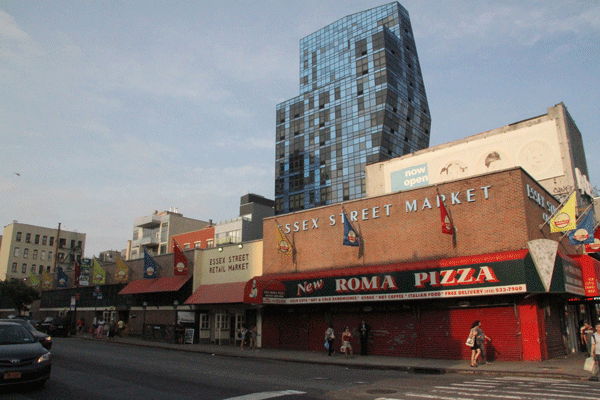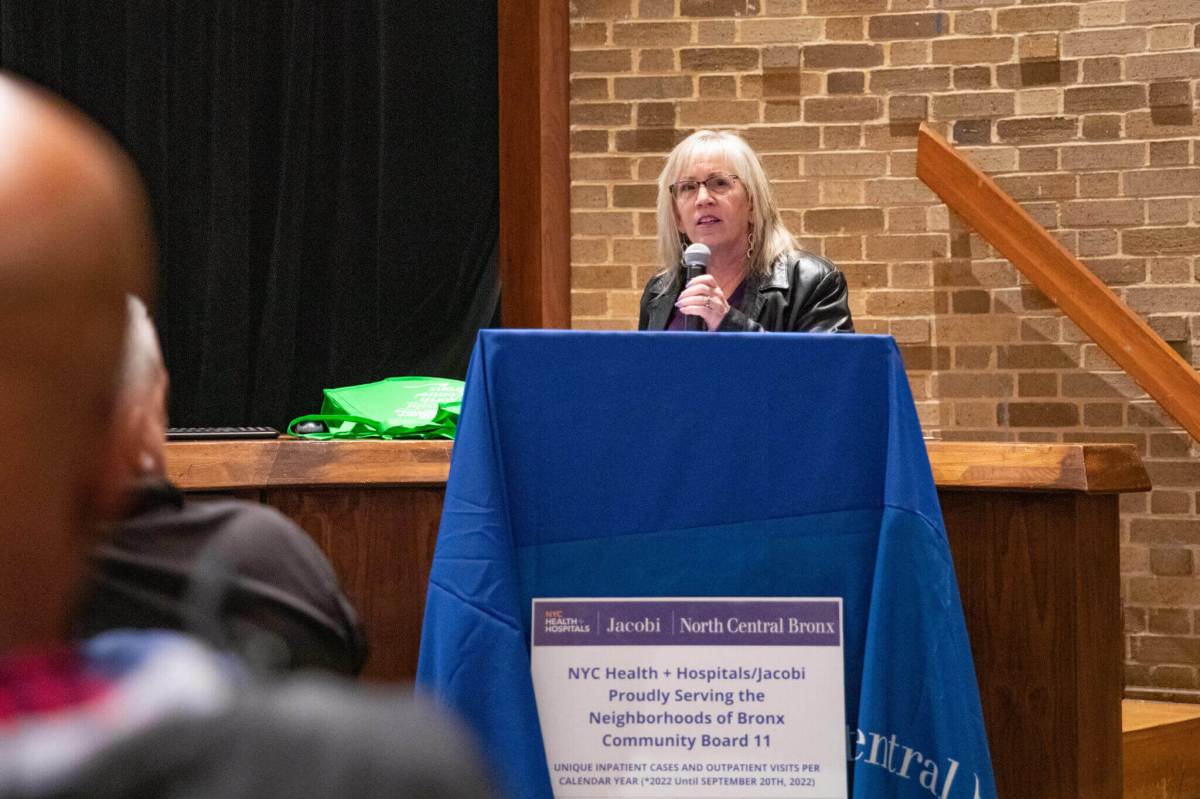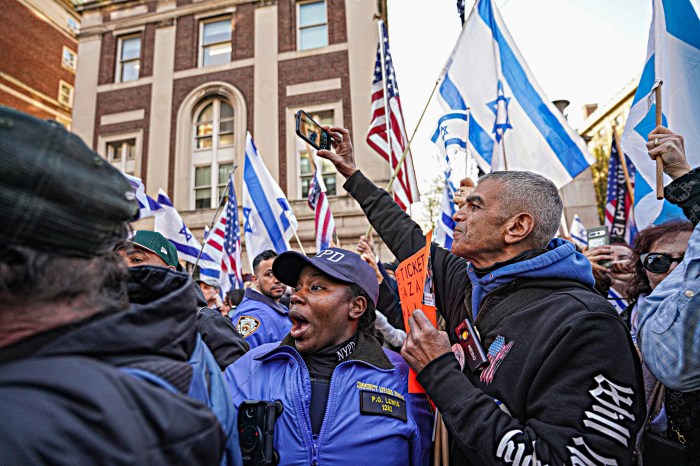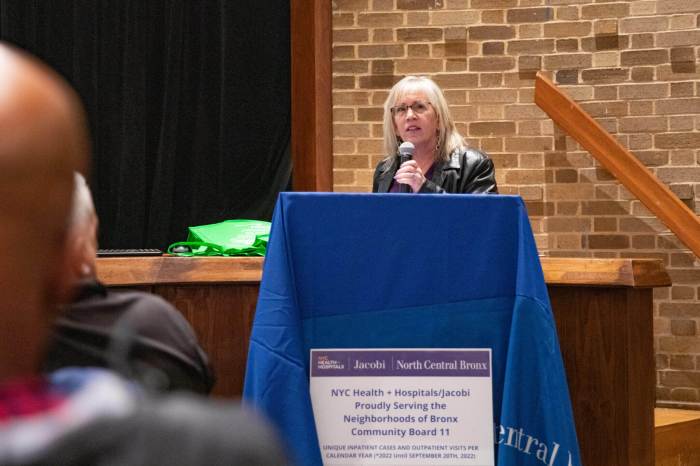 [/media-credit]
[/media-credit]
Local residents crowded into Speyer Hall at University Settlement, 184 Eldridge St., to voice their concerns and opinions about the decades-delayed project.
The town hall was held by C.B. 3’s Land Use, Zoning and Public and Private Housing Subcommittee. The full board will vote on the city’s SPURA master plan in a month from now, on May 22.
The SPURA site is the largest swath of undeveloped city-owned property in Manhattan south of 96th St. The roughly 1.65-million-square-foot area consists of nine parcels of land adjacent to the Williamsburg Bridge. The site is bordered by Delancey St. on the north, Grand St. on the south, Essex St. on the west and Clinton St. on the east.
The project’s goal is to create a thriving, financially viable, mixed-use, mixed-income development. The intention is for there to be affordable and market-rate housing units, retail and other commercial uses, and neighborhood amenities. The project sites would be knitted into thee larger, vibrant Lower East Side neighborhood.
Last week’s town hall meeting officially marked the start of the city’s uniform land use review procedure (ULURP), a process in which any application affecting city land use must be publicly reviewed. There are mandated time frames within which the application review must take place.
Once Board 3 formally votes on the proposal, the plan will then move to the Manhattan Borough President’s Office for review. After that, the City Planning Commission may make further recommendations and possible changes. Then the plan goes before the City Council and mayor for final approval. The Council is expected to discuss the plan sometime in September.
The town hall meeting followed an earlier 5 p.m. “Technical Question-and-Answer Session” in which staff from the city’s Economic Development Corporation and Department of Housing Preservation and Development were on hand to answer any questions the public had about the ULURP application process or the accompanying Environmental Impact Study (E.I.S.).
The standing-room only town hall meeting was emotionally charged. Many residents toted placards in Chinese, English and Spanish, urging the rejection of the city’s plan to include luxury housing in the area. Instead, they demanded that more low-income affordable housing be made available on the site.
Currently, the city’s SPURA plan calls for a mix of 50 percent market-value apartments and 50 percent affordable housing units to be developed, a formula that has won general support at C.B. 3.
At the meeting, however, dozens of angry local residents strode to a microphone to give city planners seated in the audience an earful. They spoke out sharply against the city’s proposal to impose a 60-year limit for affordable housing on the site and demanded that the administration guarantee permanent affordability, a position that has strong C.B. 3 support.
Representatives of grassroots organizations, including the Coalition to Protect Chinatown and Lower East Side and the National Association Against Sweatshops, also objected to any big-box stores, such as Walmart, being allowed to operate in commercial spaces planned for the site, saying it was imperative to support small businesses. (C.B. 3 has called for some limits on big-box stores).
Bob Zuckerman, executive director of the Lower East Side Business Improvement District and a C.B. 3 public member, described Walmart as a “predator.” The national chain, he said, would gobble up many small stores and put them out of business.
His concern was seconded by Jesse Kramer, owner of the Brooklyn Taco Company, a store located inside the Essex Street Market.
“Big-box retailers is not what we need,” Kramer stated. “We need more options like the Essex Street Market to help small businesses to grow.”
Zuckerman also called for some of the commercial office space slated for the SPURA site to be used to attract “people in creative fields, like graphics and technology.”
Many local residents also called for the construction of a public school in the new development, saying that Lower East Side public schools are overcrowded. Other residents said the city must provide relocation assistance to Essex Street Market merchants if they are forced to move as part of the area’s development. Both of these positions have strong backing by C.B. 3.
Other speakers asked the city to guarantee that employees in retail stores located on the SPURA site be paid a minimum of $10 an hour with benefits, or $11.50 an hour with no benefits, and that local residents be given first priority for any construction or other jobs involved with the development project.
David McWater, chairperson of C.B. 3’s Land Use Committee, told the meeting that his committee is asking the city to allow the community board to be involved in choosing retailers for the site. Regarding the issue of permanent affordable housing, he said, “It is the only way to go — a must do.”
McWater added that his committee was also “taking a strong stand” to make certain that if Essex Street Market’s vendors are relocated, that the city pay relocation costs.
In an interview after the two-and-a-half-hour meeting had ended, C.B. 3 Chairperson Dominic Pisciotta said, despite the outcry for 100 percent affordable housing at SPURA, he was satisfied with the guidelines the board passed, calling for 50 percent affordable housing and 50 percent market-rate housing. He added, however, that he and C.B. 3 are in strong support of permanent affordable housing there rather than housing that could become market rate within 60 years, as currently proposed by the city.
“Tonight you heard a number of people saying that the 50 percent guidelines we passed is acceptable and realistic,” Pisciotta said. “The community has been fighting for decades over this issue, and last January we settled on the 50 percent formula. That’s where the board is on that issue.”
Earlier, during the meeting, Pisciotta told the audience that he was pleased with many aspects of the current ULURP application.
“What we see in the ULURP that we’re considering tonight is the fruition of a lot of hard work that we put into this,” he said.
This sentiment was echoed by McWater.
“We started this process almost four years ago and the guidelines we developed are the best thing for most people in the city,” McWater said.
“We don’t think the plan is perfect,” he added, “but we’re ending 45 years of vacant lots along Delancy St. We will also be bringing in $50 million annually in jobs for this community.
“For the last 45 years there’s been too much focus on the things we disagreed on,” McWater said. “Now we’re discussing what we agree on. People are now working together to come up with guidelines.”
In one of the evening’s more emotional moments, Lo Me Eng, an elderly Chinese woman, testified about her struggle to keep up with the escalating cost of living. Eng said through an interpreter that she has lived in Chinatown more than 30 years. She begged city officials at the meeting to help low-income people.
“I used to pay $200 a month in rent, and now it’s more than $900,” she said. “Even with my husband and my own Social Security benefits, we can’t afford this rent. You must help low-income people like myself who are being pushed out of the neighborhood. You must create low-income apartments in the empty spots we’re talking about today.”
Reverend Neil Connolly, pastor of St. Mary’s Church, at 440 Grand St., also implored city planners at the meeting to make more housing available to help the neighborhood poor.
“Please help those who are hurting the most,” the reverend said. “Please help senior citizens and the poor by providing more low- and moderate-income rental apartments.”
Speaking on behalf of the Essex Street Market vendors, Anne Saxelby, owner of Saxelby Cheesemongers, 120 Essex St., said the merchants want some clear answers.
“We want to know what the Economic Development Corporation’s intentions are,” she said. “We want them to stop their wishy-washy talk.”
Saxelby said, if she and other vendors are forced to move, rents in the new location should be comparable with what they’re paying now.
“We also want to make sure we can get the same size space,” she said. “If these things don’t happen, then the Essex Street Market won’t be the same as it is today.”
Although Councilmembers Margaret Chin and Rosie Mendez were unable to attend the meeting, a spokesperson read a joint statement from them regarding the ULURP process. The politicians urged the community to keep making its positions known.
“We understand that concerns have been raised over the plan thus far,” their statement said, “and it is imperative that you continue to vocalize and advocate for the needs of your community. As the ULURP process moves forward, your voices will be our guide.”

















